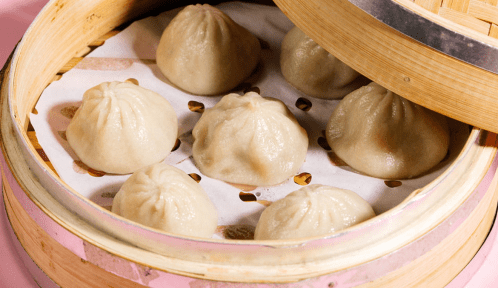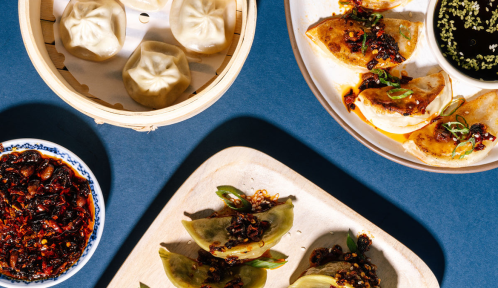‘I’m a Many-Michelin-Starred Chef, and for Me, Self-Care Means Making Soup Dumplings’
Learn the cultural significance of soup dumplings, according to an AAPI chef who recently launched their own dumpling business.

Let’s talk dumplings. You know, the delicious pockets of cooked dough with a tasty filling of your choice that can be either steamed, fried, baked, or boiled? Whatever way you choose to cook them, one thing is certain: Eating only one dumpling is impossible.
Experts in This Article
professional chef, Food Maven culinary advisor, and the founder of restaurant Lucky Danger
There’s no denying we all love ‘em. But have you ever prepared one yourself? The process is far from simple, as each dumpling is typically (very meticulously) handmade, which can take several hours to complete. Indeed, the task alone will give you a newfound appreciation for this dish.
To that end, we wanted to learn more about the complexity of dumplings—more specifically, soup dumplings—and their rich cultural background, so we caught up with Tim Ma, a five-time Michelin-awarded chef and the co-founder and culinary director of Laoban Dumplings, a frozen dumplings company.
The cultural significance of soup dumplings
One of Laoban Dumplings’ star products is soup dumplings, which, if you’ve never had one before, you’re in for a treat. What sets these apart from traditional dumplings is that upon the first bite, the dumpling will release a broth (hence the soup bit) that’s absolutely mouthwatering. Swoon.
But soup dumplings aren’t just delicious—and fun—to eat; they also carry cultural significance, especially in Chinese tradition, which makes eating them all the more special. “Like all dumplings, the soup dumpling signifies wealth and prosperity. Soup dumplings are very specific and unique dumplings to Chinese culture due to the perplexing nature of having soup inside of the wrapped dough. Most other cultures do have dumplings, but the soup nature is fairly unique to the Chinese,” Ma says.
“Like all dumplings, the soup dumpling signifies wealth and prosperity.”—Tim Ma, a five-time Michelin-awarded chef and the co-founder and culinary director of Laoban Dumplings
Because the process of making them is quite labor-intensive, cooking soup dumplings from at home regularly is unusual. “Soup dumplings are rarely made at home; they tend to be only eaten in restaurants or made at home for special occasions. I didn’t learn to make soup dumplings until I tried it in one of my restaurants as a special,” Ma says.
So, what does making soup dumplings actually entail? Ma breaks it down for us. “Technically, it can be difficult as there are many long steps, such as making a broth and letting it cool and gelatinize, all before you even make the dumpling skin and filling,” he says. Ma also points out that the double-digit number of folds made to seal the dumplings is also noteworthy. “18 folds are optimal to create the perfect soup dumpling, and the number is considered lucky in Chinese culture,” he says.
“18 folds are optimal to create the perfect soup dumpling, and the number is considered lucky in Chinese culture,” he says.
This also means that prepping this special dish typically becomes a family affair, as all hands on deck are typically needed to make a large batch. “Dumplings have been a tradition in my family for as long as I’ve been alive. It’s more of a family bonding event than making ‘food,’” Ma says. And although the chef says he could eat soup dumplings for every meal—which on many days he does—they’re primarily reserved for special occasions like celebrating Lunar New Year.

What inspired this chef to launch his own dumpling business?
“The inspiration to open Laoban Dumplings came from my co-founder Patrick Coyne’s time in China and a small dumpling shop in the village he taught in,” Ma says. The duo has been working since 2019 to perfect their dumpling recipes together. The brand sells different variations like ginger chicken, pork and chive, and veggie dumplings.
The most rewarding part of owning a dumplings business, if you ask the chef? Introducing folks to dumplings that may have never had the opportunity to access them before. “It’s been rewarding to be able to share that on such a large scale, far and wide,” Ma says.
To bring their vision to life, Ma explains that the dumplings had to have a few essential components: dough, filling (typically ground meat and aromatics), and aspic (a jelly prepared from stock). “Other than that, it’s all techniques in forming and cooking,” he says. This leads us to the most important part: Eating lots of ‘em.
But before you dig right in, Ma cautions there’s definitely a right way to do it—and avoid a dreaded third-degree tongue burn. “There are many articles and videos on how to eat a soup dumpling, and it’s more of an art than science. The way I eat them is to bite a hole in the top to let it cool, drink the soup, and then dip the dumpling in black vinegar and eat it with fresh ginger,” he says. Yep, officially drooling.
Sign Up for Our Daily Newsletter
Get all the latest in wellness, trends, food, fitness, beauty, and more delivered right to your inbox.
Got it, you've been added to our email list.










